DIY Roast Coffee
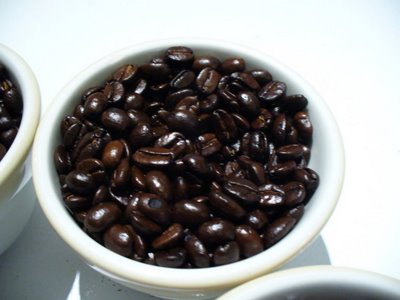
Being able to roast my own coffee is the most exciting thing that's happened in my life since Hair Bands ditched the lipstick and hairspray.
Okay...Maybe not that much!
It's one thing to preoccupy your time imagining the meteoric drop in sales Cover Girl had when the band Poison went all plain Jane. But just imagining all of the ways and types of coffee you can roast at home will have you singing "Cee Cee pick up that guitar and, uh, talk to me!" The best part is – you don't have to go out and buy a fancy, expensive coffee roaster to start roasting at home. In fact, you can use a popcorn popper.
Yes! I said a popcorn popper!
The best popcorn poppers to use are second-hand ones, like the West Bend Popper II, which you can find for several dollars in a thrift store.
Yes! I said a thrift store!
You could also find one on Ebay, but then you run the risk of getting into a bid war - and bid wars, whether you win or lose, suck. Besides, don't you agree that Ebay has taken the fun and magic out of bargain hunting? Remember the days when you scored that cool whatever-it-was and left that shop, flea market, or sidewalk sale just radiating pure joy?
You can't radiate like that online – no matter how many emoticons you use.
Of course, every rose has it's thorn and these older poppers are sometimes banged up and missing parts. They probably don't roast as well as, say, a 5 or 600 dollar Hot Top Drum Coffee Roaster, but hello, it's a frickin' popcorn popper!!
You can buy one of those $500 roasters, plus the unroasted green beans, from my favorite new small business: Sweet Maria's.

I love these people! Not only are they super friendly, but - if you can keep a secret - they threw in a little swag when we went to pick up our order from their West Oakland warehouse. We also picked up our order (twice) without giving them much notice (I have a small problem with instant gratification), yet they were very accommodating and good-natured about it.
Sweet Maria's has a huge variety of unroasted coffee beans sourced from all of the main coffee growing regions, with many of them hand-selected by Tom, the Pop of this Mom-and-Pop business (the Mom being Maria, of course). The cool thing is that not only is Sweet Maria's a certified organic coffee handler, but they also deal in certified Fair Trade coffees as well. Many of the beans they carry come from coffee farms they have personally visited - farms like the woman-owned, 10 hectare (roughly 25 acres) San Antonio farm in Nicaragua.
From this farm came one of three coffee beans I decided to start my newfound roasting endeavor with. The other two came from Mexico and Guatemala, respectively. With these, plus a bag of cheap Vietnamese robusta to test on, I began experimenting with roasting times using my hot-air popper.
Since I'd read that roasting coffee produces a lot of smoke, I called my neighbors to warn them to close their windows, and then I set up in the air-well/side exit next to our building. In reality, roasting didn't produce as much smoke as I had expected, although I still wouldn't want to roast coffee this way indoors (unless I built one of these).

With the neighbors warned, I proceeded to get out my popcorn popper, beans, and other roasting accoutrements, including: a metal colander, a large spoon, an oven mitt, a digital timer, a container to catch the chaff (in this case, a wok lid), and several ramekins to hold the freshly roasted coffee, labeled by country of origin.
Using the crappy Vietnamese beans, I started my first roast, nervous about whether the popper would get hot enough and whether it would get past the "first crack". In some of the do-it-yourself coffee roasting literature, they tell you to judge various roasts by timing of the first and second cracks. Actually, I came to find out that the first "crack" is actually the first cracking – or series of soft to loud cracking sounds, like that of, yes, popcorn.
I roasted the first batch of beans for upwards of 10 minutes and ended up with a light medium roast. I didn't hear any "loud crack", and this worried me considerably. For the second batch, I added a few more beans so that I had a rounded half-cup of beans in the popper. This time I heard cracking and witnessed my first whiffs of smoke.
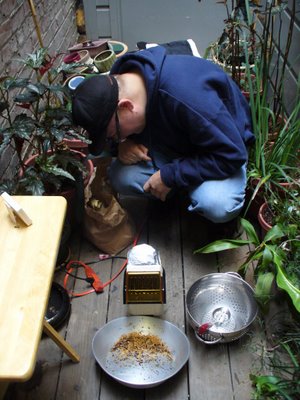
Starting to feel better now.
This next test batch gave me blackened beans in just under 8 minutes. I can only surmise that the initial problem was that the popper, like the ambient temperature, was cold and needed to warm up.

My next roast was for real, and I began my foray into home coffee roasting with a rounded half-cup of the Guatemala Antigua Peaberry "Maria Especial". This began to noticeably roast and crack around the 2 minute mark and, like the coffees that would follow, to smoke around the second cracking 3 minutes later.
While the coffee was busy roasting, my wok lid was busy catching the chaff that was blowing out of the popper.
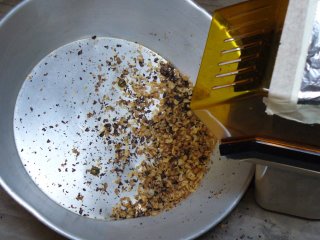
Eventually I was able to get a dark roast within 6 minutes. I roasted a half-cup of each coffee for the same amount of time and noticed that the FTO Chiapas, whose beans were slightly larger, roasted more darkly compared to the smaller beans.
Once the roast was completed, the next step was quickly cooling down the beans. It helped that it was slightly cold outside since the beans must cool down quickly right after, otherwise they keep on roasting. It also helps to cool them down by agitating them in a large metal colander.
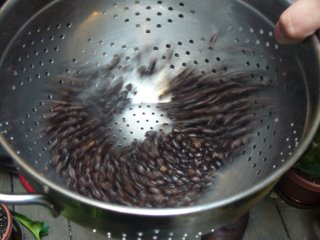
Intense aromas of freshly roasted coffee came out during this stage.

Then once the beans were just warm to the touch, I transferred them to the appropriately labeled ramekin. Labelling was necessary since later I would be testing each roast for flavor.
Once all of the coffee was roasted, it was time to get the ol' kettle a-boiling on the stove. I ground the coffee using a whirling blade grinder (I now have a burr grinder, which may make a noticeable difference). Grinding it as fine as possible without it becoming an espresso grind, I proceeded to get my filter and cups set up.
The technique to using a Filtropa filter/filter holder is to fold back the edges of the filter before you place it in the holder. Then, under a faucet, soak the inside of the filter/filter holder with water and pour out any excess. For each 10-ounce cup of coffee, use 2 rounded tablespoons of freshly ground coffee (some people suggest 3 instead). Bring your water (preferably good tap, or mineral water if you tap water tastes off) to a boil. Once it's boiling, remove it from the burner and wait 30 seconds before soaking your coffee grounds with the hot water.
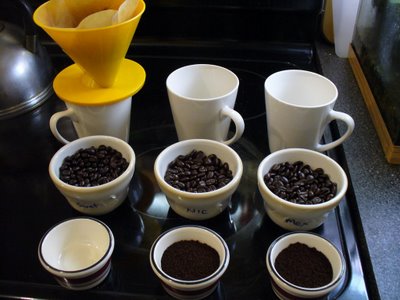
I usually fill the Filtropa holder three-quarters of the way up to the top edge – keeping the grounds constantly wet.
Once the coffee was made for all three varieties, it came down to seeing which one stood out. The results: All three, while very good and bright – with a smooth finish – were virtually identical. There were 2 notable differences, however. The first difference was that, in order from left to right, they progressive got more assertive.
Starting with the Guatemala, this coffee was mild and subdued. As my assistant coffee tester (one guess who) and I progressed to the Nicaragua, we noticed a subtle chocolate aroma and taste and it had more of an assertive presence than the first coffee. By the time we reached Mexico, the coffee had become even more assertive, although it still had basically the same taste and finish as the other two.

I now chalk this all up to the roasts being basically the same. I'm pretty sure now that these coffees should be roasted at different levels, other than Full City Roast+, to attain their best characteristics – and that's what I'll do next.
In the meantime, I'll be roasting and learning and roasting some more. As to what to do with the beans I test-roasted on: well, can we say "blend"?
Yes, I said blend!
k.
 Hello and welcome. This food blog is based in San Francisco and I'm Kevin, the guy who writes it.
You may know me from my brief, but violent and cracked out, appearance on COPS. Actually, that wasn't me - he didn't even look like me.
I'm more than happy to entertain you, but please don't be so shy. You can comment below or contact me personally at baconprss at yahoo dot com. Oh, and I like to eat sometimes.
Hello and welcome. This food blog is based in San Francisco and I'm Kevin, the guy who writes it.
You may know me from my brief, but violent and cracked out, appearance on COPS. Actually, that wasn't me - he didn't even look like me.
I'm more than happy to entertain you, but please don't be so shy. You can comment below or contact me personally at baconprss at yahoo dot com. Oh, and I like to eat sometimes.

3 Comments:
Your popper/roaster definitely has to heat up first. I'd run it without beans for a few minutes, then add your first batch.
They look great though!
Yay! Fun blog. Great stuff, home roasted coffee, and I heart Sweet Maria's.:-) I've done a similar ode to the bean at www.squidoo.com/greencoffeebeans/. :-)
Kevin, you are inspirational as always -- this time in a slightly different way:
http://blog.thisnext.com/blog/you-brew.html
Cheers!
Post a Comment
<< Home